If you are going to hand-rear a baby pigeon, you need to commit to the full process until the bird is able to fend for itself. Knowing how to take care of a baby pigeon means understanding each stage of its development and what to feed it, how to feed it, and when. It means mimicking much of the behavior of pigeon parents, including feeding them hatchling formula milk.
As an Amazon Associate, I may earn a small fee from qualifying purchases at no extra cost to you. This helps us run the site – thanks for your support!
To properly look after a baby pigeon you will need:
- A heat pad or 40-watt heat lamp
- Pigeon hatchling formula milk
- Plastic feeding syringes
If you’re considering breeding pigeons, understanding how to care for the babies is also pretty important.
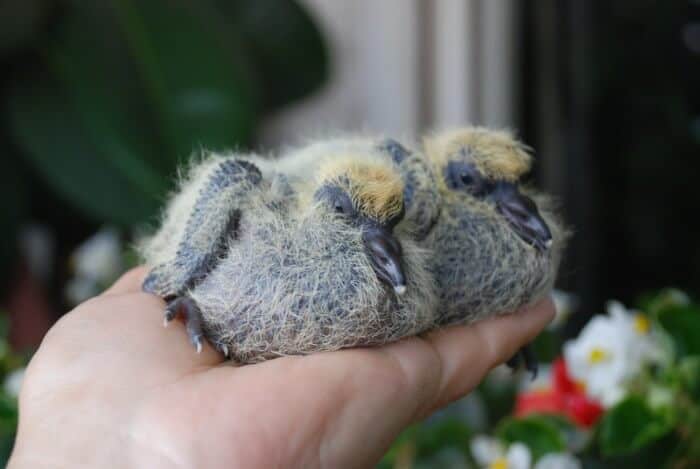
Proper care of newborn pigeons ensures their survival and ensures that you are raising healthy birds.
Use this guide to help you along the way.
Understanding Baby Pigeons
Pigeon parents are good at caring for their own babies, but if you’re breeding them or you have one with an inattentive mother, it makes sense to know what you’re up against before getting started.
Before you can care for a baby pigeon, it’s a good idea to have an understanding of what you can expect when they hatch.
Generally, it takes about 18 days for a pigeon to hatch once the mother lays her eggs (pigeons generally lay up to 2 eggs at a time).
If you’ve found an abandoned pigeon egg read our article on how to care for a pigeon egg here.
Unlike many other species of birds, pigeon babies stay in the nest for up to six weeks in some cases.
This means that your baby pigeons will need more care in the nest than other kinds of birds.
You can expect your baby pigeons to look more like adults by the time they are ready to leave the nest. Knowing this helps you make the right care choices for your pet birds.
After Hatching
You might be surprised to learn that hatching is very hard work for a baby pigeon and once it’s free of its shell, it will need to rest for about 12 hours before you need to feed it or do any other kinds of care.
The exception to this is if the baby pigeon is in distress, in which case, it’s probably best to have a veterinarian who is experienced with taking care of baby birds have a look at your pigeon.
Top Tip: If you ever find an abandoned baby pigeon and are wondering how old it is, use our pigeon age chart to work it out.
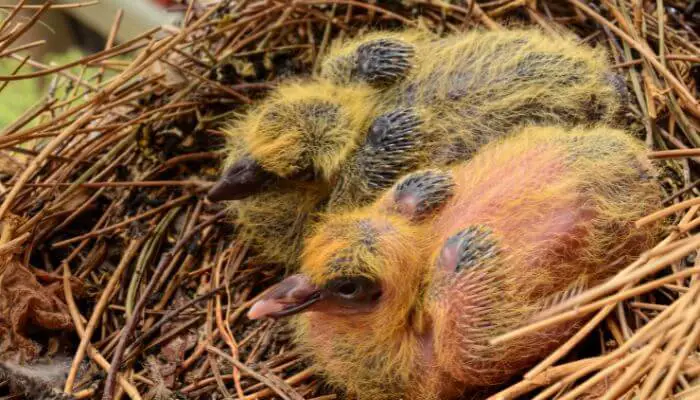
Keeping Your Baby Pigeon Warm
In general, a baby pigeon will spend the first couple of weeks of its life being brooded by the parent pigeons, so without that parent, it falls on you to keep the baby bird warm.
You won’t need to put them near a fireplace or in direct sunlight.
They will only need a gentle source of warmth, such as a heating pad set on the low level or a 40-watt heating bulb like you might use for a pet lizard.
You might also try a pet snuggle heating pad, which you can find in pet stores, or a water bottle filled with warm water and wrapped in a towel.
Make sure your baby pigeon has access to this heat at all times for the first few weeks of its life.
Some experts recommend keeping their area at about 90 degrees. You can line their box or nesting area with newspaper to help hold the heat inside.
What Do Baby Pigeons Eat?
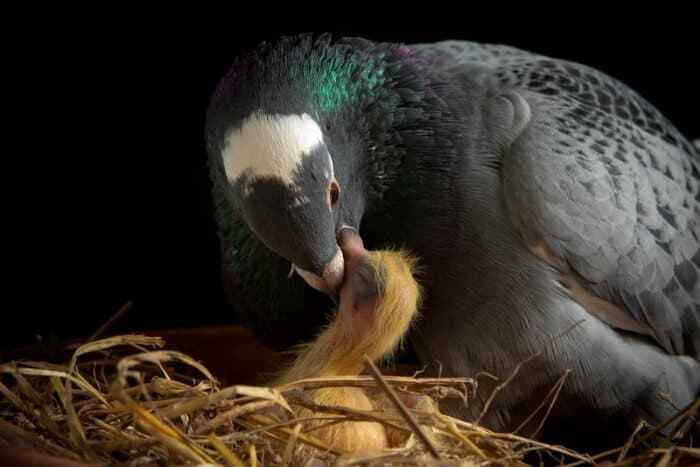
Your baby pigeon will likely sleep for the first 12 hours after hatching and you won’t need to feed it during this time.
Once it’s awake, however, you will need to feed your baby pigeon every couple of hours.
Make sure the bird is warm before feeding it. If it is cold then it won’t be able to digest its food and feeding it could kill it.
Also, do not heat food in a microwave as you don’t want to risk scalding the bird. The correct temperature for baby pigeon food is 39 degrees centigrade.
Pigeon parents feed the babies crop milk, which is a partially digested liquid that the baby bird takes directly from the mother or father bird’s mouth.
When you feed your baby pigeon, the food will need to be similar in consistency and nutrients to crop milk. There are a few ways you can do this.
Hatchling Formula
The easiest way is to buy pigeon hatchling hand-rearing formula products at pet supply stores.
These proprietary feeds are designed to mimic crop milk and will contain all the nutrients a baby pigeon needs as well as the enzymes to enable the food to be digested.
Keep in mind that you’ll need to gradually thicken the formula and increase the amount you offer as the days go by.
Good feed brands will include instructions to achieve this but you should start off with a consistency similar to skimmed milk and by ten days, it should be the consistency of thick ketchup.
Each kind of formula is a bit different so be sure you read the directions carefully and speak with a veterinarian if you need assistance.

Homemade Food Suitable for a Baby Pigeon
If you don’t have hand-rearing formula available, there are some alternatives, though you should talk to your vet before using them as they may not always provide the nutrition your baby pigeon needs.
These alternatives include
- oatmeal
- baby formula
- soft fruits and vegetables rolled into small balls using breadcrumbs
You can also buy chick crumbs ready-made from pet supply stores and Amazon.
Although the baby pigeon may indicate hunger by having a gaping open beak, do not feed too often.
Things to Not Feed Your Baby Pigeon
Contrary to what you might have heard, baby birds don’t actually eat worms, nor should you give them dairy milk as you might offer to other baby animals.
These items are not safe for a baby pigeon and won’t provide the nutrients they need to grow.
Non-dairy kinds of milk such as nut milks are suitable but they should be diluted with water. Macadamia nut milk is considered the best of non-dairy milks.
Foods that aren’t recommended for baby pigeons can make them very sick or even kill them, so it’s vital to make sure your baby pigeon is getting the right things to eat.
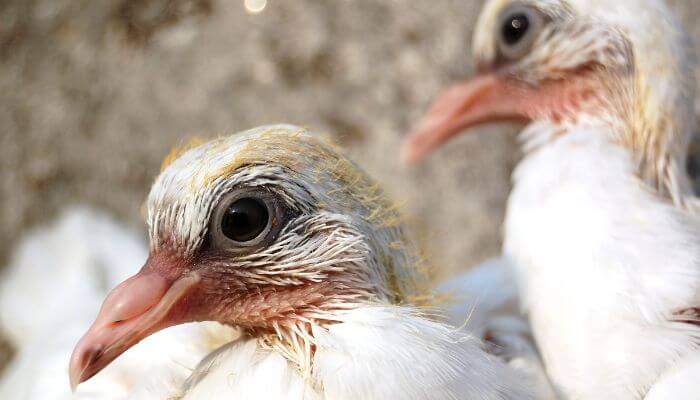
What to Feed a Baby Pigeon With Feathers?
Baby pigeons grow quickly so a hand-rearing diet should follow the appropriate timeline.
Newborn pigeons have little or no feathers. After a couple of days, the fluffy little feathers will begin to grow.
During the first four to five days while the feathers are growing, a baby pigeon being raised by pigeon parents will be fed crop milk. After this, they will be fed crop milk along with a few seeds.
On the 9th/10th day, the parents will offer a baby pigeon an adult diet along with the crop milk.
If you are hand-rearing a baby pigeon, you should follow the same pattern. Much like with human babies, you wean a baby pigeon off the liquid/formula diet onto solids.
By two weeks old, the bird should be completely covered with juvenile feathers and along with the formula (or formula substitute) you can feed it a diet of
- wild bird seed
- defrosted frozen peas
- defrosted sweetcorn kernels
- finely chopped apple
- finely chopped peanuts
- finely chopped fat balls
- finely shredded greens
- wholemeal bread crumbs
Each item should be dropped into the crop one piece at a time until the crop feels like a squishy bean bag.
After each feeding, dip the bird’s beak in clean warm water to encourage it to drink.
Always make sure the crop is empty before the next feeding session.
By week three, a baby pigeon can digest adult food and will not require crop milk.

How to Feed Your Baby Pigeon
Now that you know what your baby pigeon needs to eat, you need to learn how to offer that food to them, which isn’t as easy as it might sound.
For the most part, you will want to mimic the natural feeding methods of the parent pigeons.
In a natural pigeon nest, the baby bird will insert its beak into the mother or father pigeon’s mouth and the crop milk will be transferred from parent to baby.
You can do this by feeding your baby pigeon the food you’ve chosen via a small plastic syringe, a clean plastic bag or a small baby bottle. Give your baby pigeon the chance to open its beak so that you can gently transfer the food into its crop.
It’s important to note that baby pigeons get stressed very easily and you need to be on the lookout for this during feeding.
Since hand feeding your baby bird is different than in the wild, the baby’s instincts may make it difficult at first.
If you notice your baby is in any kind of distress or appears to be breathing through an open beak, back off and give the bird a chance to rest before you attempt to feed it again.
Too much stress in a baby pigeon can lead to a heart attack so pay close attention to its stress levels and adjust your feeding time and methods accordingly.

This article was written by our qualified veterinarian Cristina.
This is part of our commitment to providing you with the most trustworthy veterinary advice for your pigeons.
How Much To Feed a Baby Pigeon
You know what to feed your baby bird and how to feed it, but now you need to know how much the baby needs to eat.
You can use your baby pigeon’s crop as a guide for feeding.
The crop can be found between the throat and stomach.
Because all pigeons have a differently sized crop, this is your main means of determining how much it needs to eat.
Monitor the crop as you feed and stop when it feels a bit soft and squishy. It should feel like a balloon that’s filled about three-quarters full with liquid.
A baby bird also has small bubbles on its shoulders that fill up when it’s had enough to eat.
When they’re full, stop feeding. Overfeeding your pigeon can be deadly so pay close attention as you feed.
Once the crop has become flat and the baby pigeon is cheeping for food, you can feed it again.
Most experts suggest allowing the crop to completely empty at least every 24 hours.
That’s because if you overfill it, the baby may end up with pockets that can trap food and lead to sour food that can make your baby pigeon ill by causing sour crop.
If the crop doesn’t appear to be emptying regularly, contact your veterinarian for advice.
Also Read: Do Pigeons Leave Their Babies?
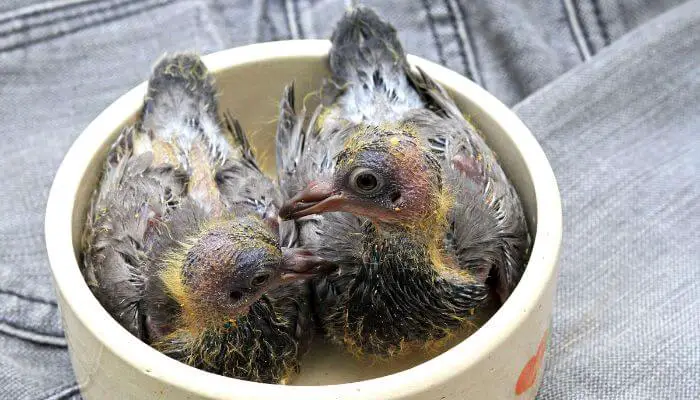
A Home for Your Baby Pigeon
Feeding your baby pigeon and keeping it warm are the two most important things you can do for your pet bird. However a comfortable home is also vital.
Making a bed that’s similar to the nest is great. A basket lined with a towel is an easy way to do this.
Be sure that there’s a solid base on the bottom to stabilizes the baby’s feet so they don’t splay, which can lead to feet problems as the pigeon gets older.
Never use things the baby might eat, such as sand or wood chips.
As the baby gets older, be sure that its bedding is wide and large enough to give it space to spread its wings so they can become strong and prepare it to leave the nest.
Sources:
